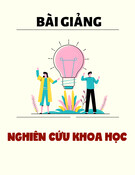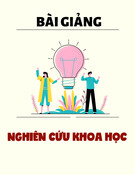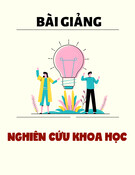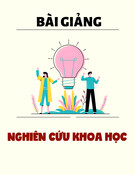
127
HNUE JOURNAL OF SCIENCE
Educational Sciences 2024, Volume 69, Issue 5A, pp. 127-138
This paper is available online at https://hnuejs.edu.vn/es
DOI: 10.18173/2354-1075.2024-0088a
THE FACTORS INFLUENCING PRESCHOOL TEACHERS' SUPPORTIVE
BEHAVIORS FOR THE INCLUSION OF 18-36 MONTH-OLD CHILDREN
WITH SPECIAL NEEDS BASED ON THE APPLICATION
OF UNIVERSAL DESIGN FOR LEARNING
Dinh Thanh Tuyen
Department of Early Childhood Education, Hanoi National University of Education,
Hanoi city, Vietnam
Corresponding author Dinh Thanh Tuyen, e-mail: tuyendt@hnue.edu.vn
Received November 10, 2024. Revised November 24, 2024. Accepted December 11, 2024.
Abstract. This study aimed to identify factors influencing preschool teachers' behavior in
supporting the inclusion of 18–36 months-old children with special needs, based on the
Universal Design for Learning (UDL) framework. Through surveys conducted among
preschool teachers at various educational institutions, the study analyzed supportive
behaviors, assessed their frequency, and identified factors such as peer collaboration,
managerial support, professional development opportunities, and challenges encountered.
Findings reveal that inclusive practices are significantly influenced by support from peers
and school management, alongside motivation for professional growth. To enhance UDL
implementation, the study recommends fostering collaboration, managerial backing, and
professional development programs to address challenges in inclusive education.
Keywords: Universal Design for Learning (UDL), Special Needs Inclusion, Preschool
Education, Teacher Support Behaviors, Early Childhood Development.
1. Introduction
Children with special needs aged 18-36 months require special support to integrate into the
preschool learning environment [1]. At this age, children are in a rapid phase of physical,
emotional, and social development, making timely and appropriate intervention critically
important [2]. Universal Design for Learning (UDL) has been recognized as an advanced
educational approach designed to optimize learning for all students, especially those with special
needs [3]. UDL not only provides flexible methods for delivering knowledge but also supports
the holistic development of children by creating a learning environment that is both welcoming
and tailored to individual needs [4].
However, the implementation of UDL in practice requires preschool teachers to have a deep
understanding of UDL principles as well as the specific needs of children. This demands not only
professional knowledge but also continuous effort in adjusting and applying appropriate teaching
methods. Additionally, teachers need classroom management skills and patience to monitor and
assess children's progress [5].
Researching factors influencing preschool teachers' support for children with special needs
is crucial. Understanding these factors helps develop strategies for effective inclusive education,

Dinh TT
128
ensuring all children can thrive in preschool. This approach fosters individual growth and a more
inclusive, equitable learning environment [6].
2. Content
2.1. Theoretical Foundation and Theoretical Framework
2.1.1. Universal Design for Learning (UDL)
Universal Design for Learning represents a comprehensive educational framework
developed to minimize barriers to teaching and maximize learning opportunities for all students,
including those with diverse needs [4]. The core of UDL lies in three main principles: providing
multiple means of representation, multiple means of action and expression, and multiple means
of engagement [3]. In the context of early childhood education, particularly for children with
special needs, UDL plays a crucial role in ensuring that each child has fair access to education,
tailored to their individual needs, thereby creating an inclusive learning environment [7].
2.1.2. Relevant Theories on Supporting 18-36 Months-Old Children with Special Needs
Using UDL in Preschools
The application of UDL in early childhood education for 18-36 months-old children with
special needs is not only based on the foundational theory of UDL but also reinforced by other
important child development theories. One prominent theory is Vygotsky's theory of the Zone of
Proximal Development (ZPD)[8]. Researching factors influencing preschool teachers' support for
children with special needs is crucial. Understanding these factors helps develop strategies for
effective inclusive education, ensuring all children can thrive in preschool. This approach fosters
individual growth and a more inclusive, equitable learning environment.
Additionally, Gardner's theory of Multiple Intelligences (1983) is also a crucial theoretical
foundation for applying UDL in early childhood education. Gardner suggests that people possess
various types of intelligence, such as linguistic, logical-mathematical, spatial, and interpersonal
intelligence [9]. Each child has a unique intelligence profile, and teachers need to identify and
leverage these strengths in the teaching process. When applying this theory to UDL, teachers can
design diverse learning activities, ensuring that each child has the opportunity to develop
according to their predominant intelligence.
The combination of Vygotsky's ZPD and Gardner's Multiple Intelligences theories
strengthens UDL's application in early education by supporting personalized learning and social
development. This approach optimizes each child's potential, particularly those with special
needs, fostering both academic growth and an inclusive learning environment [10], [11].
The Inclusive Special Education Theory emphasizes optimizing inclusion through flexible
teaching methods that focus on individualization and diversifying educational approaches. This
theory underlines the importance of creating comprehensive learning environments that cater to
the diverse needs of students with special needs. Recent studies advocate combining inclusive
curriculum design with assistive technology to enhance the learning outcomes and social
integration of children in inclusive classrooms. Florian and Spratt (2013) proposed a framework
that interrogates inclusive practices by addressing systemic barriers and embracing diversity
within educational systems [12]. Furthermore, Rouse (2024) highlights that inclusive practices
not only improve learning outcomes for children with special needs but also benefit their peers
by fostering a culture of empathy and collaboration [13].
The Functional Behavior Support Theory focuses on analyzing and addressing the specific
behaviors of children with special needs to implement effective support strategies. This theory is
grounded in observing and assessing behavioral patterns to develop tailored intervention plans
that minimize barriers to learning and inclusion. Sugai and Horner (2009) emphasize integrating
positive behavior support systems within a multi-tiered framework to enhance educational

The factors influencing preschool teachers' supportive behaviors for the inclusion of…
129
outcomes for children with special needs [14]. Additionally, Dunlap et al. (2018) stress the
importance of individualized plans, such as Prevent-Teach-Reinforce (PTR) strategies, to provide
practical solutions for managing challenging behaviors while fostering social and academic
growth[15]. These approaches create structured yet adaptive environments that promote
successful inclusion in early childhood education settings.
2.1.3. Supporting Behavior for 18-36-Month-Old Children with Special Needs Using UDL
in Preschools and Behavioral Manifestations
2.1.3.1. Overview of Children with Special Needs
Children with special needs between the ages of 18–36 months require tailored interventions
to help them thrive in preschool environments. At this developmental stage, children undergo
rapid physical, emotional, and social growth, making timely and appropriate support critical for
their inclusion [2]. According to the Universal Design for Learning (UDL) framework, supportive
behaviors refer to actions taken by teachers to ensure that all children, including those with special
needs, have equitable access to learning opportunities [3]. These behaviors encompass using
diverse teaching methods, adapting materials, and creating a welcoming and flexible classroom
environment that allows every child to participate meaningfully [4].
Children in this age group with special needs may exhibit developmental delays or
differences such as communication, social interaction, and motor skills. For instance, some
children may face barriers in verbal communication, requiring non-verbal support tools like visual
aids or gestures [1]. Others may struggle with sensory processing or mobility, necessitating
environmental adjustments or the use of assistive devices. Additionally, these children may
require more individualized attention to navigate group activities and routines, as highlighted in
Gardner’s theory of Multiple Intelligences, which emphasizes catering to unique strengths and
abilities [9].
2.1.2. Supportive Behaviors for Inclusion
Supporting 18 to 36-month-old children with special needs under the UDL framework
involves diverse teaching methods and a flexible learning environment, enabling holistic
development and promoting inclusivity. Here are the behavioral manifestations of preschool
teachers supporting children with special needs, based on the three main principles of the
Universal Design for Learning (UDL) framework (CAST, 2018) [3]:
2.1.2.1. Providing Multiple Means of Representation
• Using diverse teaching materials (UDL1): Teachers use various formats (images,
videos, audio, and models) to help children absorb information more easily, like using picture
books or toys when teaching about animals.
• Adjusting learning materials (UDL2): Teachers adapt materials for children with
special needs, such as enlarging text, using clear illustrations, or employing interactive tools for
better visual presentation.
• Explaining content in multiple ways (UDL3): Teachers use different approaches (real
materials, images, interactive activities) to ensure all children, including those with special needs,
understand concepts like counting.
2.1.2.2. Providing Multiple Means of Action and Expression
Allowing children to express themselves in various ways (UDL4): Teachers encourage
diverse expressions such as drawing, singing, storytelling, or acting, helping children with special
needs choose a method that matches their abilities.
Using supportive technology (UDL5): Teachers use tools like tablets and educational
software to assist children with special needs express thoughts, for example, using drawing apps
to tell stories or dictation software for writing.

Dinh TT
130
Guiding children in using support tools (UDL6): Teachers guide and monitor the use
of tools (like tablets or touch pens) to help children express thoughts effectively, ensuring these
tools are truly beneficial.
2.1.2.3. Providing Multiple Means of Engagement
• Creating a flexible learning environment (UDL7): Teachers should create a flexible
and welcoming learning environment where all children, including those with special needs, feel
welcomed and motivated to learn. This can include setting up interest-based learning corners,
allowing children to choose learning activities they prefer, and encouraging them to participate in
group activities.
• Encouraging self-choice (UDL8): Teachers allow children to choose learning activities
or participation methods in lessons. For example, when conducting a project on animals, teachers
can let children choose the animals they want to study and how they want to present their learning
results (such as through drawings, models, or oral presentations).
• Designing meaningful and reality-connected learning activities (UDL9): Teachers
design learning activities related to daily life and children's interests. This helps enhance children's
interest and engagement, especially for those with special needs. For example, teachers can
organize field trips or outdoor activities where children can learn from their surroundings.
When these behavioral manifestations are systematically and consistently implemented, they
help preschool teachers effectively support the integration of children with special needs in the
educational environment, ensuring that every child has the opportunity to develop
comprehensively in a way that best suits their needs and abilities.
2.1.3. Factors Influencing Preschool Teachers' Behavior in Supporting 18-36-Months-Old
Children with Special Needs Using UDL in Preschools and Research Hypothesis
In supporting preschool children with special needs, teachers must consider several factors
that influence their behavior and effectiveness. These factors include implementing modern
educational innovations, developing professional skills, and reducing learning barriers.
Furthermore, social collaboration and technology use are essential for fostering an inclusive
educational environment. However, pressures from professional and managerial requirements
may negatively impact teachers’ intentions and behaviors. The table below summarizes these
factors based on the Universal Design for Learning (UDL) framework.
Table 1. Factors influencing preschool teachers' behavior in supporting children with special
needs based on the Universal Design for Learning framework
Factor
Indicators
Citations
Trend of Innovation
in Child-Centered
Early Childhood
Education (XTDM)
1. Encourage teachers to design learning activities that cater to
each child’s individual needs and interests.
(Lohmann et
al., 2018;
Gauvreau et
al., 2019; Bích
& Nho, n.d.)
[16], [17], [18]
2. Focus on creating flexible learning environments that
encourage children’s freedom to explore and learn.
3. Promote active participation of children in the learning
process through interactive learning methods.
4. Adjust teaching plans to ensure that every child can
participate and develop according to their abilities.
5. Allow teachers the flexibility to modify teaching methods
based on the needs of different groups of children.
Teacher Training
and Capacity
Development
(DTPT)
1. Participate in specialized training courses on UDL and
inclusive education.
(Ok et al.,
2017; Ellen
McGuire-
2. Develop skills in creating inclusive lesson plans.
3. Enhance the ability to use supportive technology in teaching.

The factors influencing preschool teachers' supportive behaviors for the inclusion of…
131
4. Improve skills in managing inclusive classrooms.
Schwartz &
Arndt, 2007)
[19], [20]
5. Attend workshops and courses to update new knowledge.
Barriers to Learning
Under UDL
Application (RC)
1. Language and communication barriers for children:
Nonverbal communication aids for children with speech
difficulties are not readily available.
(Anstead,
2016)
[21]
2. Mobility barriers for children.
3. Shyness and avoidance behavior in children.
4. The classroom environment lacks adequate facilities and
equipment.
5. Parental acceptance of their child's actual condition.
6. Teachers have not received sufficient training on UDL.
7. Lack of learning resources according to UDL principles.
8. Resistance to educational innovation among some teachers.
Ability to
Collaborate and
Social Interaction
(KNHT)
1. Support from school administrators and collaboration with
colleagues in lesson planning.
(Anstead,
2016)
[21]
2. Regular communication with parents to better understand
children's needs.
3. Organize teacher group meetings to share experiences.
4. Encourage parental involvement in children's learning
activities.
5. Develop effective communication skills between teachers
and children.
Application of
Supportive
Technology
(UDCN)
1. Use learning software that meets the special needs of
children.
(Rose et al.,
2005)
[22]
2. Apply technology devices such as tablets, and interactive
whiteboards in teaching.
3. Provide communication support tools such as illustrated
software, learning cards, and audio recordings to help preschool
children develop communication skills.
4. Update and upgrade teaching technologies to meet the
diverse needs of children.
Pressure from
Professional and
Management
Requirements (AL)
1. Teachers struggle to balance management requirements and
support for children with special needs.
(Algraigray,
2023; Kim &
Olesova,
2022; Nguyễn
et al., 2022)
[6], [23], [24]
2. Work overload may reduce teachers' motivation to support
children.
3. Lack of time for preparation and adequate training.
4. Pressure to comply with rigid school regulations.
5. Lack of support from management in adjusting the
curriculum to meet special needs.
Based on the factors influencing the supportive behaviors of preschool teachers toward the
inclusion of children with special needs according to the Universal Design for Learning (UDL)
framework, the research hypotheses can be formulated as follows:
1. Hypothesis 1 (H1): The trend of innovation in child-centered early childhood education has
a positive impact on teachers' supportive behaviors toward the inclusion of children with special needs.




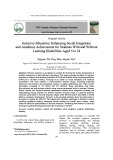
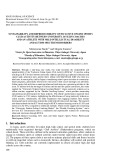



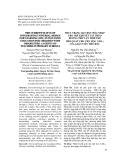




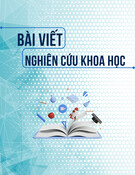
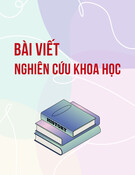
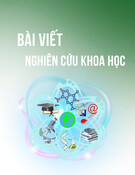

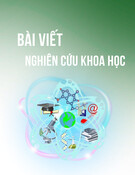

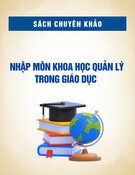
![Định hướng giáo dục STEM trong trường trung học: Tài liệu [chuẩn/mới nhất]](https://cdn.tailieu.vn/images/document/thumbnail/2025/20251124/dbui65015@gmail.com/135x160/25561764038505.jpg)
